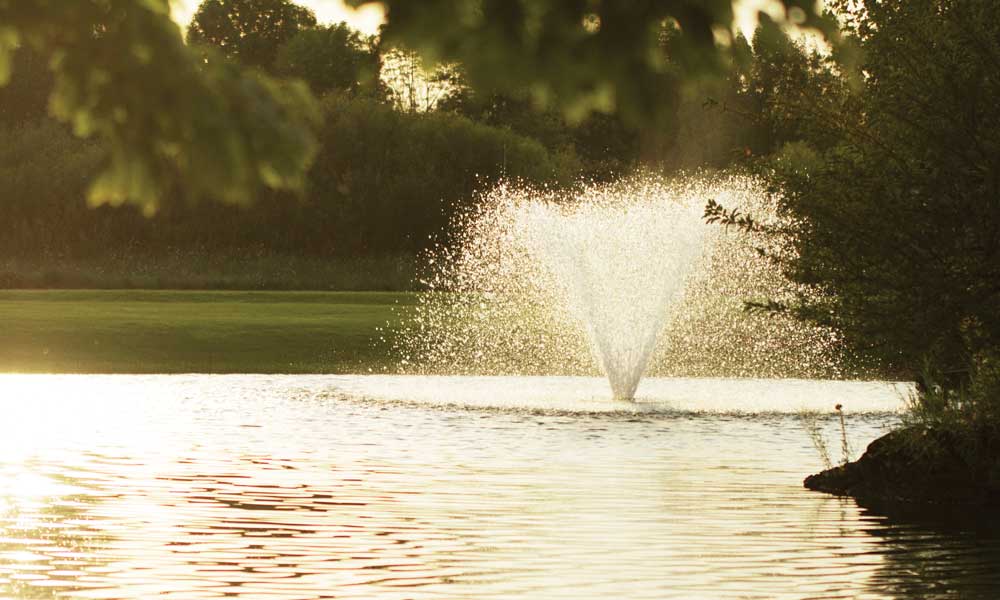Aerators: The Power of Oxygen


Scott Aerator Company has been in the business of serving its clients with quality, reliable pond products since 1963. Located on the shores of Lake Michigan, this family-owned company was founded by William Scott to manufacture de-icing equipment for private docks, marinas and even boats that remain in the water year-round in sub-freezing conditions.
In 1986, John P. Van Kampen and his wife Joan purchased the company and began expanding its product lines to include aerators and fountains. In addition to serving the golf industry, products manufactured by Scott Aerator are used for a variety of applications, both in the U.S., and worldwide. Today Van Kampen’s son John is the company’s Vice President of North American sales. John shared, “We’ve sold fountains to the royal family of Saudi Arabia, for the Bush family compound at Kennebunkport and even Dollywood.
“However, we take the golf course market very seriously. We work with many superintendents throughout the U.S., Central and South America, assisting with water analysis along with design and selection of the proper water feature for their application. We also try and stay as involved as possible in the Michigan Golf Course Owners Association and other regional and national associations.”
Are Aerators or Fountains Right for Your Golf Course?
Whether you view ponds or lakes as integral to strategic playability, fundamental for drainage, a storage point for irrigation water or simply one of the prettiest parts of your golf course, water features are an important component of most course designs. Making the choice between the use of an aerator or a fountain generally comes down to aesthetics vs. purpose. Fountains are used when the visual appeal of the spray and the sound of moving water are the greater objective, while aerators are typically selected with the intent that the device will aid in controlling algae, inhibit insect breeding and increase oxygenation of the water.
Both products add oxygen by circulating water. The strong flow of water helps control the build-up of algae, sludge and weeds without the use of chemicals. Mike DeVries, a board member with the Holland Golf Club, which uses three Scott Aerator fountains, stated, “The aerating fountains not only make our ponds look good, but they also help put oxygen into the water and keep the algae from building up.”
Carl Tibstra, a technician and quality control supervisor for Scott Aerator, observed, “We’ve seen the trend toward using less pond chemicals and fewer pond treatments and more towards aeration for keeping ponds clean and algae-free. More superintendents and club managers are asking about solar and wind powered options for aeration as well.”
To use an aerator effectively in a body of water, the Scott Aerator Company recommends that a pond or lake cover at least one-eighth of an acre in surface area and that the water depth be no less than 28 inches with the use of a .5 hp aerator or 38 inches with the use of a 1.5 hp aerator. For fountains, a 28-inch depth minimum is required in order to use a .5 hp pump or a 42-inch minimum depth if using a 1.5 hp pump. All of the products manufactured by Scott Aerator are engineered for use in either fresh or salt-water environments.
Seasonal Use or All Year Long?
In many parts of the country, aerators run around the clock throughout the year. Even if a golf course does not run its equipment during the winter months, no special winterization is required when using products from Scott Aerator. The company designed its aerators and fountains to withstand sub-zero conditions without sustaining damage. They can be safely left in the water during the coldest weather. The only circumstance under which any winterization would be necessary is when optional light kits have been mounted to the aerator or fountain. In such cases, the lights should be removed from the device before ice formation occurs. Operational costs rarely deter golf courses that prefer to leave fountains and aerators running 24/7. Units manufactured with a .5 hp motor typically cost between eight and ten cents per hour to run, while a larger, 1.5 hp unit with a 230-volt motor costs, on average, about twelve cents per hour to operate.
All .5 hp Scott Aerator products with a 115-volt motor draw 19 amps when running; the same units at .5 hp with 230-volt motors draw only 5 amps or at 1.5 hp wwith a 230-volt motor draw 10.6 amps when running. Because of the lower amperage draw, a 230-volt motor is more economical to operate than the 115-volt motor is, although both offer comparable spray patterns and flow rates. More importantly, the cost of operating an aerator for longer periods is offset by the improvement in water quality and the reduction in chemical costs, dredging or other methods that might be used to fight an algae overgrowth.
John Van Kampen said, “We do see more folks leaving their aerators in all year round, and we do recommend this for a few reasons. Ponds that have remained ice covered for long periods run the risk of depleting oxygen levels and fish kills. This can be prevented by leaving the aerator in place and running throughout the winter months, so that a small area of the pond remains free from ice and allows for the introduction of oxygen into the water.
“The pond aerators which we manufacture at Scott Aerator are water lubricated, so the longevity of our products is greatly increased if they are never removed from the water. An added plus to water lubrication compared to oil lubricated pond aerators is that there is no possibility of oil leaching into the pond, plus there is no oil to add or change. Also, leaving the pond aerator in place all year round means you don’t have to drag the boat out twice a year to install in the wet spring and remove in the cold fall!”
Installation
Installing an aerator or fountain is a remarkably simple process. Under the unit’s floatation device two eyebolts are attached to the fountain or aerator. By tying a nylon rope to each of the two eyebolts and attaching a concrete block or boat anchor to the opposite end of the rope, the device will remain securely anchored. Place the weighted ends of the rope at least twenty feet apart and positioned on the bottom of the pond or eliminate the weights by tying the ropes to stable objects on shore.
All Scott Aerator products use 12-gauge submersible cables and standard cord lengths ranging from 25 to 100 feet in length. After determining the desired placement for the aerator or fountain, a superintendent may decide to purchase a unit with a custom-length power cable, which is available upon request.
Peter Klondike, the company’s head of research and development, summed up Scott Aerator Company’s manufacturing commitment. “An important factor in the dependability and durability of a fountain aerator is its construction,” he explained. “After nearly 54 years of experience, we’ve found our rugged, high-density polyurethane and stainless steel construction holds up best to the rigors of continuous operation.”
To learn more about Scott Aerator’s high quality, value-based pond fountains and aerators go to www.scottaerator.com.
Recent Posts
Memphis Country Club: A Golfer’s Study in Precision and Tradition
If you have ever teed it up at Memphis Country Club, you know this isn’t…
Foley Company attains GCSAA Silver Partner Status
Foley Company, a leader in turf equipment innovation and technology, affirms its support of the…
Harrell’s continues longstanding support of the GCSAA Foundation
Harrell’s LLC, a leading distributor of customized agronomic products for turfgrass since 1941, has donated…
City of Orlando Announces New State-of-the-Art Driving Range at Dubsdread Golf Course
The City of Orlando is excited to announce the construction of a brand-new, state-of-the-art driving…
Discover Puerto Rico for Great Golf Trips and After-Round Activities, Amenities
Golfers cannot live by the game alone which is why Puerto Rico provides the perfect…
Q&A with a Multi-talented Golf Course Architect – Part 2: Making the Rounds – Installment 39
This column features recollections of the author’s 37 years as a golf writer. These installments…


